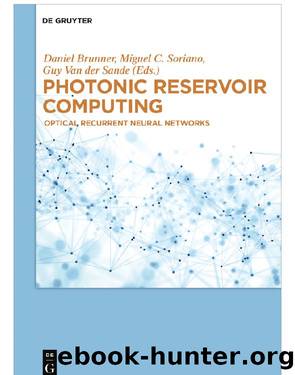Photonic Reservoir Computing by Daniel Brunner Miguel C. Soriano Guy Van der Sande

Author:Daniel Brunner, Miguel C. Soriano, Guy Van der Sande
Language: eng
Format: epub
Publisher: Walter de Gruyter
Published: 2019-04-15T00:00:00+00:00
5.5.1 Interconnection structure through system dynamics
When , the state of a given virtual node at time t depends on the states of the previous virtual nodes due to the noninstantaneous response of the system (T) to the inputs. The strength of this dependency for low-pass filtered systems is an exponentially decaying function of the separation of the virtual nodes.
For the case of (i.âe., the only connection between the virtual nodes are through the system dynamics) and a time series prediction task (NARMA10), it was found that is the best choice for virtual nodes [6]. This ratio leads to significant coupling between neighboring virtual nodes, as illustrated in Figure 5.7. In Figure 5.7(a), the node output never leaves the transient regime. Since the state of one virtual node depends on the state of the previous ones because of the system dynamics, the equivalent connectivity graph is given by Figure 5.7(b). All nodes are connected to adjacent nodes, with the connection weights exponentially decreasing as we move further back in time. They also experience the self-coupling as in this case.
The relation between the timescales can be used to establish a more formal link between the traditional formulation of reservoir computing, such as given in Section 5.2 and the virtual interconnections created through the system dynamics. In what follows, we will derive an approximate interconnection matrix describing the coupling between virtual nodes processing information from different input time steps where they are only connected through the system dynamics. For simplicity of notation, in the following we normalize all times with respect to the intrinsic time scale of the nonlinear system T, that is we work in units where . In the following, we consider nonlinear equations of the form:
Download
This site does not store any files on its server. We only index and link to content provided by other sites. Please contact the content providers to delete copyright contents if any and email us, we'll remove relevant links or contents immediately.
The Complete Stick Figure Physics Tutorials by Allen Sarah(6658)
Secrets of Antigravity Propulsion: Tesla, UFOs, and Classified Aerospace Technology by Ph.D. Paul A. Laviolette(3660)
Thing Explainer by Randall Munroe(3350)
The River of Consciousness by Oliver Sacks(3008)
The Order of Time by Carlo Rovelli(2754)
I Live in the Future & Here's How It Works by Nick Bilton(2539)
How To by Randall Munroe(2521)
A Brief History of Time by Stephen Hawking(2488)
The Great Unknown by Marcus du Sautoy(2200)
What If?: Serious Scientific Answers to Absurd Hypothetical Questions by Randall Munroe(2184)
Blockchain: Ultimate Step By Step Guide To Understanding Blockchain Technology, Bitcoin Creation, and the future of Money (Novice to Expert) by Keizer Söze(2149)
Midnight in Chernobyl by Adam Higginbotham(2091)
Networks: An Introduction by Newman Mark(2008)
The Meaning of it All by Richard Feynman(1918)
Easy Electronics by Charles Platt(1877)
The Tao of Physics by Fritjof Capra(1866)
When by Daniel H Pink(1785)
Midnight in Chernobyl: The Untold Story of the World's Greatest Nuclear Disaster by Adam Higginbotham(1782)
Introducing Relativity by Bruce Bassett(1761)
